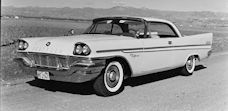Chrysler Sebring 2nd generation
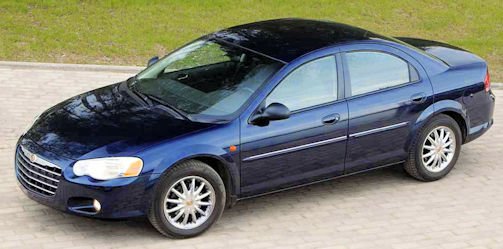 | |
Production period: | 2000 to 2007 |
Body versions: | Sedan, cabriolet |
Engines: | Gasoline: 2.0-2.7 litres (104-149 kW) |
Length: | 4844-4921 mm |
Width: | 1792 mm |
Height: | 1394-1401 mm |
Wheelbase: | 2692-2743 mm |
Curb weight: | from 1435 kg |
In the fall of 2000 appeared the second generation of the Sebring (internal type designation: JR), which was available as a sedan and again as a convertible and was formally first shown at the New York International Auto Show (NYIAS) in 2000.
History
Power for both came from the known 2.4-liter in-line four-cylinder engine with five-speed manual transmission or a 2.7-liter V-6 engine with four-speed automatic transmission, as a convertible in the sports version GTC also with five-speed manual transmission. In the export there was also a two-liter four-cylinder engine with 104 kW (141 hp). Chrysler Sebring Cabrio and Sedan are manufactured at the Sterling Heights Assembly Plant in Sterling Heights, Michigan, USA.
The sedan of the Chrysler Sebring debuted as the successor to the Chrysler Cirrus and parallel to the Dodge Stratus. Again, a 2.0 (with five-speed manual) or 2.4-liter four-cylinder engine or a 2.7 -liter V6 engine, each with four-speed automatic transmission, were used.
In the 2004 model year, the Sebring was given a revision mainly in the front area. In keeping with the new look of Chrysler, the Sebring Sedan also has a new fascia and grille. In addition, the Sebring Sedan offers new 16-inch painted aluminium wheels optional on LE and standard on LX models. Chrysler Sebring Cabrio and Sedan are offered in two new exterior colours: Satin Jade and Graphite Metallic. Interior colour options for the Sedan are Taupe and Sandstone. The Cabrio adds new Deep Jade interior colour, while cabriolet top colour choices are Black and Sandalwood.
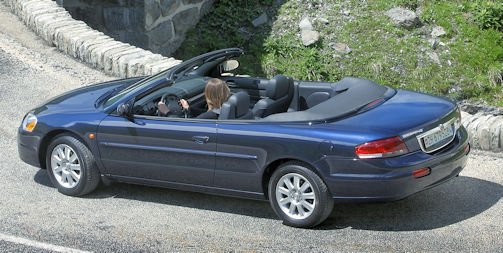
The Sebring Sedan also prominently displays the Chrysler winged badge on the deck lid. Chrysler Sebring Sedan offers many new interior amenities including an electrochromic rear-view mirror as well as steering wheel radio controls. Freshened interiors include new door trim panels and leather trimmed seats. which offers a new front fascia, grille and wheels. The Chrysler winged badge is placed prominently across the top of the shapely grille reflecting the new family look for the Chrysler brand, and the scalloped headlamps are curved with jewel-like details. A new 16-inch painted aluminium wheel is now standard on Cabrio also includes steering wheel radio controls for improved driver convenience, available as an option with leather interior. The Limited model now also includes suede detail on leather seats.
At the beginning of 2007, it was replaced by the model with the internal name "JS". In Russia, the Sebring with the converted Chrysler production facilities under the name GAZ Volga Siber was further developed and marketed.
In the fall of 2000, the formal first time at the NYIAS 2000, the Sebring Coupé (internal type designation: ST -22) appeared with a completely new body on the basis of the JR series. Chrysler offers two versions of its Sebring Cabrio: LX and Limited. The Sebring Cabrio is available with a choice of two engines both petrol a 2.7 V-6 engine with four-speed automatic transmission with AutoStick, and a 2.0 four-cylinder engine and five-speed manual transmission. AutoStick provides the control of a manual transmission with the convenience of an automatic. The cabriolet top also features a solid glass back window and electric rear window defroster, as well as a four-window-down system. When the button is depressed to fold back the cabrio top, all four windows go down simultaneously.
The Sebring Sedan is available with a choice of two trim levels – LE and LX – and two petrol engines – a 2.7 V-6 and a 2.0 four-cylinder power unit. Both engines are mated to a four-speed automatic transmission with AutoStick. For the 2.0 engine, a five-speed manual transmission is also available. It differed from the sedan and the convertible besides smaller optical details also in the motorization. There was the Coupé with a 2.4-liter four-cylinder engine and a maximum power of 106 kW from Chrysler or a 3.0 -liter V6 engine from Mitsubishi, which made a maximum of 149 kW. The parallel model was the Dodge Stratus Coupe. In the model year 2003, the front of the coupe was also modified.
The Sebring Coupé ST-22 was manufactured until the end of 2005.
Standard and Optional Equipment
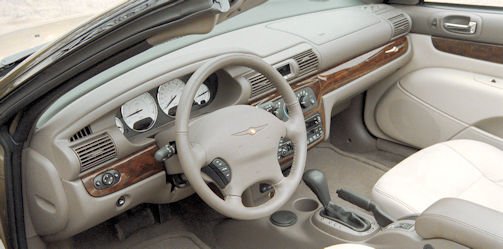
The Chrysler Sebring Cabrio and Sedan safety features including multi-stage front air bags, front seat belt pretensioners, repositioned higher head restraints, internal emergency trunk release, and improved occupant protection with additional front door beams and an improved safety cage structure also new headlamps that feature improved beam pattern and brightness.
Active safety features include a four-wheel disc brake system, traction control and anti-lock braking system called “ABS Plus.” The ABS Plus system senses speed differences among all four wheels during braking in a turn or in avoidance manoeuvres, and rations a precise amount of force to each wheel so the car stays stable.
Additional standard equipment includes air conditioning, remote keyless entry, power windows, speed-sensitive power door locks, dual illuminated visor vanity mirrors and a lockable console. A short/long arm (SLA) front suspension system provides superior balance between handling stability and ride comfort, while the rear multi-link suspension contributes to refined ride and agile handling by reducing friction.
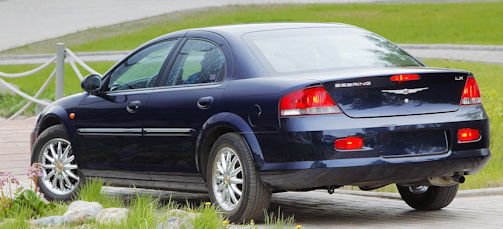
Rating
Technical
-
Technical Specifications Chrysler Sebring Cabrio and Sedan, 2nd Gen (2000-2007)
Dimensions and Capacities
Cabrio
Wheelbase 2692 mm
Track, front 1528 mm
Track, rear 1528 mm
Overall length 4921 mm
Overall width 1792 mm
Overall height 1401 mm
Fuel tank capacity 60.6 litresSedan
Wheelbase 2743 mm
Track, front 1528 mm
Track, rear 1528 mm
Overall length 4844 mm
Overall width 1792 mm
Overall height 1394 mm
Fuel tank capacity 60.6 litresEngine 2.7 Petrol
Six-cylinder, V-type, 60-degree, active-intake,SMPI, liquid-cooled
Displacement 2736 cc
Bore and stroke 86 mm x 78.5 mm
Valve system DOHC, 24 valves, four valves per cylinder
Compression ratio 9.7:1
Maximum power 149 kW (203 hp DIN) @ 5900 rpm
Maximum torque 260 Nm @ 4950 rpm
Transmission Four-speed automatic with AutoStickCabrio Sedan
Top speed 210 km/h (130 mph) 216 km/h (134 mph)Fuel consumption (litres/100 km)
Combined cycle 10.7 10.7
Ex-urban cycle 8.4 8.4
Urban cycle 14.7 14.7
Combined CO2 255 g/km 250 g/kmEngine 2.0 Petrol
Description Four-cylinder, in-line, SMPI, liquid-cooled
Displacement 1996 cc
Bore and stroke 87.5 mm x 83 mm
Valve system DOHC, 16 valves, four valves per cylinder, hydraulic
lash adjusters, cast aluminium roller rocker arms
Compression ratio 9.8:1
Maximum power 104 kW (141 hp DIN) @ 5700 rpm
Maximum torque 188 Nm @ 4350 rpmTop speed 200 km/h (124 mph) 180 km/h (112 mph)
Fuel consumption (litres/100 km)
Combined cycle 8.3 9.4
Ex-urban cycle 6.6 7.5
Urban cycle 11.1 12.7
Combined CO2 197 g/km 225 g/kmTransmission Five-speed manual Four-speed automatic
© Motor car History
-Note: Maintenance and Repair Manuals available for registered user



